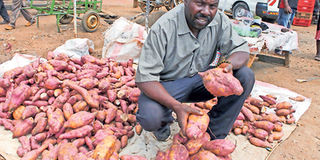Kenyans urged to eat orange sweet potato

Peter Kihiko sorts sweet potatoes for sale in Elburgon. The potatoes come in several varieties and colours such as white, yellow, orange and purple. PHOTO | JOHN NJOROGE | NMG
What you need to know:
- The potato is rich in nutrients. The white fleshed variety, for instance, has the highest amount of starch while the purple one is high in anthocyanins, extracts that protect the liver.
- Sweet potato is a pro-poor food security crop. This is probably because it has low input requirements — meaning it does not need a lot of labour or fertiliser during production.
- According to the International Potato Centre, just 125g of fresh orange fleshed sweet potato root contain enough beta-carotene to provide the daily pro-vitamin A of a five-year-old.
- A more feasible way is bio-fortification, which is basically a method of increasing micronutrient content through conventional breeding.
Sweet potato is a storage root crop and a staple food in many parts of Kenya. According to literature, it is the fifth most important food crop in developing countries.
Sweet potato comes in several varieties and colours such as white, yellow, orange and purple.
The potato is rich in nutrients. The white fleshed variety, for instance, has the highest amount of starch while the purple one is high in anthocyanins, extracts that protect the liver.
They also have antioxidant activity and enhance one’s memory.
The yellow and orange fleshed varieties on the other hand are high in beta-carotene, which is a form of vitamin A.
Sweet potatoes also contain calcium and phosphorous, which are good for bone health. They too have fibre, known for health benefits like promoting weight loss.
Sweet potato is a pro-poor food security crop. This is probably because it has low input requirements — meaning it does not need a lot of labour or fertiliser during production.
It is also versatile —can be eaten in different forms such as boiled, baked, steamed or fried, for breakfast, lunch, dinner, dessert or even as an in-between meals snack.
The high content of beta-carotene, which our bodies can turn into vitamin A, in orange fleshed varieties makes them particularly important.
According to the International Potato Centre, just 125g of fresh orange fleshed sweet potato root contain enough beta-carotene to provide the daily pro-vitamin A of a five-year-old.
Vitamin A-deficiency is one of the most critical forms of undernourishment, commonly referred to as hidden hunger.
It continues to be a problem for children and expectant women, particularly in Africa.
It is responsible for illnesses and conditions such as night blindness and severe visual impairment.
Lack of the vital vitamin also increases the risk of infections in children under five, such as measles and diarrhoea.
It has also been blamed for stunted growth and death.
Vitamin A has also been found to have the ability to reduce T cell count in HIV+ children.
Vitamin A supplementation has been employed as a way to combat it. However, that has proved to be expensive.
MILLED INTO FLOUR
A more feasible way is bio-fortification, which is basically a method of increasing micronutrient content through conventional breeding.
So how does one select an orange fleshed sweet potato variety when buying?
Research has shown that the variety can be identified through colours.
Some orange-fleshed varieties come in cream skin, others purple, purple-red, light purple and cream.
The yellow fleshed varieties, which also contain beta-carotene but in lower amounts, come in brownish orange or copper colour.
Orange fleshed sweet potatoes can be eaten in many forms and at different times of the day.
However, other than the usual boiling and roasting, most people do not know how else to consume them and hence may not eat much.
The sweet potato can be consumed as baked chips or crisps. The whole root is peeled and thinly sliced.
The slices can then be glazed with olive or any other oil and baked in an oven at about 1,800 degrees Celcius for 15 minutes. The slices are allowed to cool before being eaten.
Sweet potato puree can be substituted with wheat flour when baking cake.
The sweet potato roots are washed, peeled and diced — cut in cubes.
Water is then added to submerge them halfway.
The cubes are then covered with a lid and allowed to boil on a stove, jiko or cooker.
Once boiled, they are blended to get a liquid that is thick and smooth. This is what is known as puree.
The puree can then be added to cake batter and mixed thoroughly to get an even batter with a thin consistency.
The mixture is then baked in an oven at 1,800 degrees Celsius for 25 to 30 minutes. The cake is then allowed to cool.
Sweet potato can also be milled into flour. The flour can be used to make pancakes. The flour can also be composited with wheat flour and other highly nutritious flour like soybean and used to make cake, bread and other pastries.
****
Facts
The pro-poor food crop
Sweet potatoes have calcium and phosphorus, credited for improving the health of one’s bones.
Producing sweet potatoes is not labour intensive. It does not need a lot of labour or fertiliser.
Sweet potatoes come in a variety of colours such as yellow, white, orange and purple.
Research shows that it is the fifth most consumed food in the developing world.




